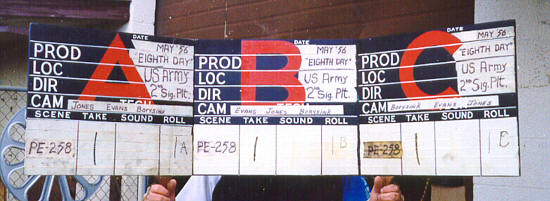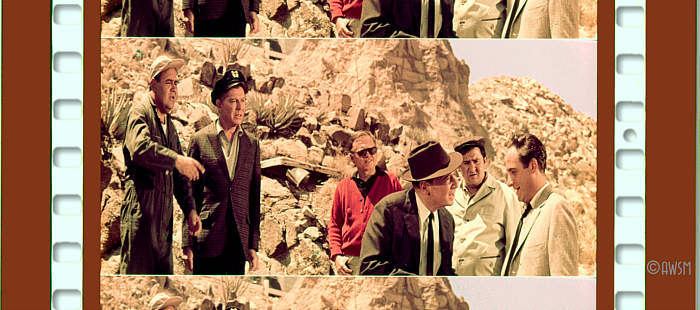|
|
|
|
|
|
|
|
|
|
|
|
|
|
|
|
|
|
|
|
|
|
|
|
|
|
|
|
|
|
The Cinerama Film That Never Was
Courtesy of Jeff Joseph - Sabucat ProductionsIn 1956, Cinerama began production of a new film entitled "The Eighth Day", which told the story of atomic power. Seen in this photo is a scene slate that carries data for each of the three cameras. How much of the film was actually shot is unknown. What is known is that there was three strip footage made of one or more nuclear tests, also shot in CinemaScope and VistaVision by the U.S. Army.
Note that the news release was published one year after the date shown on the camera slate.
New Cinerama Production Unit A new production and distribution company is planned by Cinerama, with an eye to utilizing the process in industrial, advertising, public relations, and government agency fields. First production on the agenda is "The Eighth Day," in cooperation with the Atomic Energy Commission. Background research has already been made. Operations will begin "when the Stanley Warner Cinerama Corp.'s exclusivity terminates," according to Cinerama president, Hazard E. Reeves.
Reprinted from "International Projectionist" May 1957
Courtesy of David Johnson
Cinerama records the launch of the U.S. nuclear submarine Seawolf. So who has the film???
photo courtesy of Peter Rondum
Goes Into The Dumper
Cinemiracle proved unsuccessful, financially, and the owners of the system sold out to Cinerama, Inc. Whatever benefits Cinemiracle might have offered were overlooked and the only thing considered of any value was the one film produced in the process, Windjammer, which was run in the Cinerama installations without the mirrors (or smoke, for that matter).
The unquestionable success* of both Wonderful World of the Brothers Grimm and How The West Was Won breathed new life into the system and stirred significant interest with the major studios. Unfortunately, developmental work on a single film version of Cinerama was killed when the company was sold to Pacific Theatres. Since Ultra Panavision 70 had been able to fool people in segments of How The West Was Won it was decided to adopt that process as the photographic basis for the single film system and specially prepared "rectified" prints were made to show the 70mm film on the deeply curved Cinerama screen.
*Brothers Grimm was not a major money maker in many markets, though it did fairly well in Europe. While the film was not critically acclaimed, the use of Cinerama to tell a story (the first in the U.S.) was welcomed by the critics and public alike.
It's A Mad, Mad, Mad, Mad World (1963)
Film courtesy of Jeff Joseph, SabuCat Productions
Shown above is a frame from a 70mm Ultra Panavision 70 print "rectified" for Cinerama. The faded color is typical of Eastmancolor prints of this vintage. In creating the special prints, Technicolor unsqueezed the anamorphic image and optically copied it while introducing a slight compression on the sides of the frame to compensate for elongation during projection on the oblique screen sides. "Mad World" was nearly completed when producer/director Stanley Kramer was approached with the offer to show it as the first single lens Cinerama production. This fact will give the reader an idea of just how much thought went into making a Cinerama picture in any process other than the real 3-strip system. While Cinerama photographed and projected an image of 146 degrees, the Ultra Panavision 70 photography in "Mad World" rarely used lenses that covered more than 50 degrees. Stanley Kramer, much to his credit, has stated flatly that this was nowhere near being Cinerama. The impact of Cinerama had been killed and only its reputation kept the name alive. Several other films were photographed in Ultra Panavision 70 for Cinerama release, including The Greatest Story Ever Told (but the most tedious movie ever projected), The Hallelujah Trail ("Mad World" with horses replacing the Chrysler products), and Khartoum, an intelligent treatment of the Chinese Gordon story.
It's hard to figure out what the caption writer thought he was saying in this hokey publicity picture. The lenses held by Kramer and Conroy are standard 35mm Snaplite projection lenses while the big guy held by Lessman is a new 70mm Cinerama projection lens. Kramer is either bewildered or bored.
Courtesy of Robert C. WeisgerberSince using any anamorphic photographic process requires a bit more work than so called "flat" or spherical systems, lazyness and/or studio bean counters soon figured that the specially rectified 70mm Cinerama prints could be done away with and normal 70mm, in the form of Super Panavision, Todd-AO, or 70mm Technirama blowups could be used. The single film format provided some good films and there were more than a few turkeys served in the grand Cinerama installations. The quality and enjoyability of those films was in no way enhanced by presentation on the curved screen.
Adding Insult To Injury
This Is Cinerama?
Film courtesy of John MitchellShrunken to a width of 68.5mm, here we see the final insult. Several of the Cinerama 3-Strip films were optically printed onto flat 70mm stock and shown in the single film format. While the photography retained much of its original impact, the mindless method of producing the prints eliminated a large percentage of the side panels. This fact was not terribly noticeable because the failure to utilize the rectification process caused the narrowed sides to stretch out to nearly the width of the center.
In addition to This Is Cinerama, Cinerama Releasing also presented a compilation of Soviet Kinopanorama films, produced by United Roadshow Productions, under the title of Cinerama's Russian Adventure in a 70mm composite version. This film, while mildly interesting, suffered from dinner plate sized grain and horrible color, due to grossly inferior Soviet film stocks in use at the time.
Triple frame set from Cinerama's Russian Adventure
Taken from souvenir book, the photo is retouched to hide panel lines.Not a very cheerful page, was it?
You are on Page 5 of
E-mail the author
CLICK HERE©1997 - 2010 The American WideScreen Museum
http://www.widescreenmuseum.com
Martin Hart, Curator












